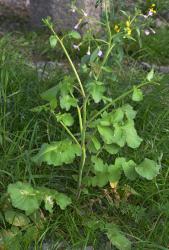- Taxon
- Gallery
- ≡ Raphanus sativus L., Sp. Pl. 669 (1753)
- = Raphanus sativus var. longipinnatus L.H.Bailey (1920)
- = Raphanus caudatus L.
Annual or biennial. Taproot tuberous, napiform or cylindric, white or red, 1–3–(8) cm diam. Stems often reddish, (10)–40–100 cm tall. Rosette and lower stem lvs lyrate-pinnate, rarely simple; terminal leaflet (2)–3–6 × (2)–3–6 cm, wider than rest of lf; lateral leaflets in 1–4 distant pairs. Stem lvs simple, rarely with a pair of basal lobes, orbicular to lanceolate, 1–3 cm long. Racemes 15–40 cm long. Pedicels 1–2 cm long, stout at fruiting. Sepals 6–8 × 1–2 mm. Petals usually white, sometimes pink or mauve, rarely pale yellow, mauve-veined, 15–20 mm long. Silique (1)–5–12-seeded, ovoid to cylindric, not or scarcely constricted between seeds, not breaking into segments, veined or very weakly ribbed, tapering at apex, 20–60 × 8–15 mm. Seeds c. 3 mm long.
[From: Webb et al. (1988) Flora of New Zealand. Volume 4. Raphanus sativus L.]
Flowering: Oct.–Mar.–(May); Fruiting: Oct.–Mar.–(May)




